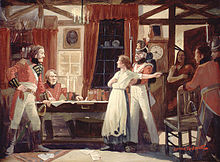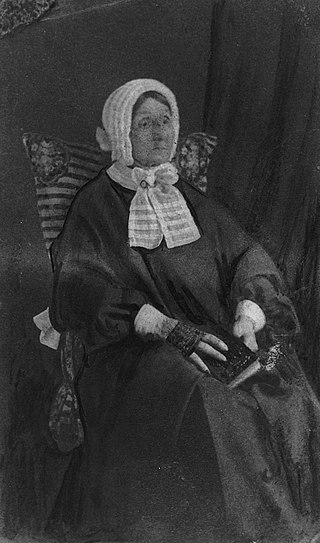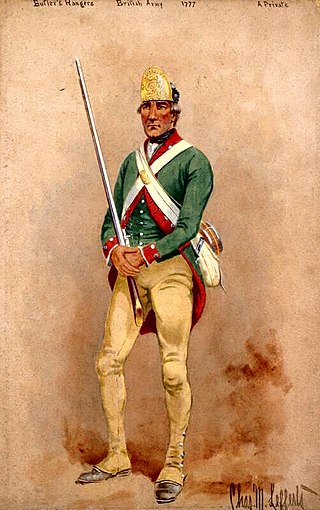Revolutionary War
The American Revolution divided the family. Some family members were active Patriots who enlisted in the Continental Army, while others served in Patriot militias. A significant number were Loyalists who left their homes and families and joined British provincial regiments such as Butler's Rangers.
In April 1775, just before the start of the Revolutionary War, a meeting of roughly 100 Patriots was held in Westchester County to select representatives for a meeting in New York that would choose delegates for the Second Continental Congress. At the same time, roughly the same number of Loyalists gathered at the house of Abraham Hatfield, then marched in protest to the Patriot meeting. Afterwards, 312 inhabitants of the county signed a document affirming their loyalty to the British Crown, including Elias, Francis, Israel, Joshua, and Benjamin Secord. [4] [5]
In May 1775, male residents aged 21 and over in Orange County were asked to sign a resolution known as an association test, indicating their loyalty to the provincial government and their rejection of British rule. Nine members of the Secord family signed, however, five refused to do so. [3]
A few years before the Revolution, brothers John, Peter and James Secord settled on the North Branch of the Susquehanna River in what is now Pennsylvania. In the spring of 1777, the three, accompanied by five of their sons, journeyed to Fort Niagara and joined the British Indian Department. Following the August 1777 Siege of Fort Stanwix, authorization was given for John Butler to raise the "a corps of rangers" which became known as Butler's Rangers. Seven of the eight enlisted in the new regiment, while James elected to continue serving in the Indian Department. [6]
After the war, members of the Secord family who had demonstrated their loyalty to the British Crown received grants of land in what is now Ontario and New Brunswick. Their children were also eligible for land grants once they reached adulthood. [7] Loyalists could also submit claims for losses as a result of the war although only Solomon Secord and William Secord appear to have done so. [8]
Loyalists

John Secord: John Secord (1725–1804), son of Daniel Sicard (1698-1765), served with the 5th Company, Upper Battalion, Westmoreland Militia during the French and Indian War. Shortly before the Revolution, he settled on the North Branch of the Susquehanna River. He was arrested as a British spy in March 1776 but successfully appealed his imprisonment to the Connecticut government. He joined the British Indian Department at Fort Niagara in 1777 and later transferred to Butler's Rangers. John was discharged in October 1778 due to his age and settled across the Niagara River in what became Niagara Township. [6] [9]
Peter Secord: Peter Secord (1726-1818), son of Daniel Sicard (1698-1765) enlisted in the 5th Company, Upper Battalion of the Westchester County Militia during the French and Indian War. He settled on the North Branch of the Susquehanna River shortly before the Revolution. Peter joined the British Indian Department at Fort Niagara in 1777 and later transferred to Butler's Rangers. He was discharged in October 1778 due to his age. In 1780, Peter settled across the Niagara River in what became Niagara Township, and with his brother James built and operated the first mill in the region. He later moved to the Long Point area. [6] [9]
James (Jacques) Secord: James Secord (1732-1784), son of Daniel Sicard (1698-1765), enlisted in the 5th Company, Upper Battalion of the Westchester County Militia during the French and Indian War. He settled on the North Branch of the Susquehanna River shortly before the Revolution. James joined the British Indian Department at Fort Niagara in 1777. James retired sometime after April 1779. Three of his sons joined Butler's Rangers. In 1780, James settled across the Niagara River in what became Niagara Township, and with his brother Peter built and operated the first mill in the region. His children were granted 2,000 additional acres of land for their father's service during the war. [6] [9] [10]
Solomon Secord: Solomon Secord (1755–1799), son of James Secord (1732-1784), joined the British Indian Department at Fort Niagara in 1777, later transferred to Butler's Rangers, and was promoted first to corporal and then sergeant. He later received a commission as a 2nd Lieutenant. After the war he settled across the Niagara River in what became Niagara Township. [6] [10]
Stephen (Etienne) Secord: Stephen Secord joined the British Indian Department at Fort Niagara in 1777, later transferred to Butler's Rangers, and rose to the rank of sergeant. After the war he settled across the Niagara River in what became Niagara Township. [6] [10]

David Secord: David Secord (1759-1844), the son of James Secord (1732-1784), joined the British Indian Department at Fort Niagara in 1777, was wounded at the Battle of Fort Stanwix, and afterwards joined Butler's Rangers. After the Battle of Wyoming he was tasked with guarding three American prisoners. [6] According to family tradition, the prisoners had been part of a party that had attacked a Mohawk village and killed the wife of Oneida Joseph. When Joseph heard that the murderers were prisoners, he demanded to be allowed to kill them. Secord would not permit it, to which the Chief replied, "I kill them or kill you," as he thrust his spear through Secord's coat. [4] He was later promoted to corporal and then sergeant. After the war he settled across the Niagara River in what became Niagara Township. Secord was appointed a justice of the peace in 1796 and represented 2nd Lincoln in the 5th Parliament of Upper Canada from 1809 to 1812. During the War of 1812, Secord served as a Major in the 2nd Regiment of Lincoln Militia. He claimed to have fought in every significant engagement in the Niagara region during the War of 1812, and was in command of his regiment at the Battle of Lundy's Lane. He represented 3rd Lincoln in the 7th Parliament from 1817 to 1820. [6] [11]
John Secord: John Secord (1757–1830), known as 'Deaf John' due to his hearing loss from a cannon shot, joined the British Indian Department at Fort Niagara in 1777, later transferred to Butler's Rangers, and served as a private until his discharge in October 1778. In 1780, he settled across the Niagara River in what became Niagara Township. [6] [9] In a certificate attached to his Upper Canada land petition, he is described as "a brave man, having after the Battle of Wyoming, when the Loyalists were retreating towards Niagara (and found it necessary to have a better supply of Provisions) returned by desire of the commanding officer to Wyoming, with only eight men and brought from the Enemy, One Hundred and forty head of Cattle – upwards of ninety Head were drove to Aughquaga, and there issued to the troops, and the others used for an immediate Supply." [10]
Daniel Secord: Daniel Secord, son of Daniel Secord (1724-1818) joined Brant's Volunteers in 1777. After the war, Joseph Brant granted Secord a 999-year lease on 200 acres in the Haldimand Tract. [9] [10]
John Secord: John Secord, son of Daniel Secord (1724-1817) joined the New York Volunteers and rose to the rank of Sergeant. He was discharged in New Brunswick in 1783, but after a few years joined his brother in Upper Canada. [9] [10]
Silas Secord: Silas Secord (c. 1755– ?), son of Peter Secord (1726-1818) Secord joined the British Indian Department at Fort Niagara in 1777, transferred to Butler's Rangers, and rose to the rank of sergeant. After the war, Silas settled across the Niagara River in what became Niagara Township, but later moved to the Long Point area. [6] [10]
William and Elias Secord: William and Elias Secord, sons of Elias Secor (c. 1717– ?) emigrated in 1783 to what later became New Brunswick. They were part of the exodus of Loyalists from New York City, having crossed British lines into the city in 1777. During their time in New York, William worked in the shipyard while Elias served in the Prince of Wales' American Regiment until discharged in 1778 due to illness. Both William and Elias married and had children while living in New York. [3] [9]
Patriots
Josiah Secord: Josiah Secord (1751-1832), son of Isaac Secor (1715-1759), served in the 2nd Regiment Dutchess County Militia. [12] Several years after the war he emigrated to Upper Canada and settled in the Niagara District. [9]
John Secor: John Secor (1756–1830), son of David Secor (1721-1797), enlisted in the 5th New York Regiment in June 1777, was promoted to corporal in August 1780, and deserted in December 1780. The 5th New York saw action at the Battle of Forts Clinton and Montgomery in 1777 and during the 1779 Sullivan Campaign. [13] [14]
Isaac Secor: Isaac Secor (1755–1836), son of David Secor (1721-1797) enlisted in the 3rd New York Regiment in July 1775. He was court-martialled for attempted desertion in October 1775 and was fined a month's pay. [15] He was with the regiment during the Invasion of Quebec but was discharged due to frostbite before the Battle of Quebec. Secor reenlisted in the Continental Army several times and was with the regiment at the Battle of Long Island in 1776, the Battle of Forts Clinton and Montgomery in 1777, and the Sullivan Campaign in 1779. Between enlistments he served in the 2nd Regiment Orange County Militia. [3]
James Secor: James Secor (1751-1820), son of David Secor (1721-1797), enlisted as a sergeant in the 3rd New York Regiment in 1775. The 3rd Regiment saw action during the Invasion of Canada and the Battle of Quebec. He returned to New York when his enlistment expired and served as a sergeant in the 2nd Regiment Orange County Militia. [3]
Additional members of the Secor family served in the militias of Orange, Westchester, and Dutchess counties. Jonas Secor is recorded as having served in the New York Levies. [14]




















